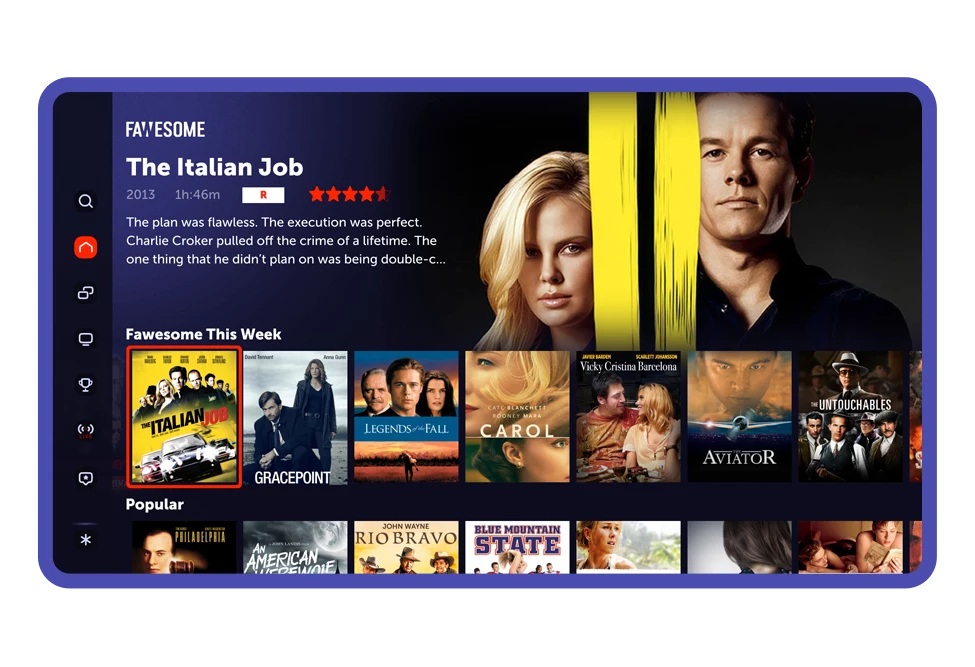Samba TV: Streaming, Linear TV Set New Viewing Records
Streaming was up by 56% in the second half of 2024 but traditional TV also grew by 8%, highlighting the importance of live events

SAN FRANCISCO—New data from Samba TV shows, as expected, that time spent streaming continues to grow at a rapid pace, growing year-over-year by 56% in the second half of 2024. Meanwhile, linear TV, which is often seen as being in decline, also saw healthy growth, with an 8% pop.
The State of Viewership Report for the second half of 2024, which analyzed 51 billion hours of linear and streaming TV consumption, also highlighted a surge in total television viewership driven by major live events, widespread adoption of ad-supported streaming and the growing impact of AI-powered contextual targeting in transforming advertising effectiveness.
More specifically, live sports and news events were particularly important in driving large audiences. Interestingly, viewership of the presidential debates beat the NFL by more than 10 million households, proving politics can pull Super Bowl-sized audiences, Samba TV reported. Another notable finding was that higher-income households see fewer ads.
"Live events are the new battleground of audience engagement—transforming passive viewers into active participants while rewriting the rules of media consumption,” Samba TV co-founder and CEO Ashwin Navin said. “As streaming and linear audiences converge around live sports, we're witnessing a seismic shift where AI-driven insights turn fragmented viewership into strategic opportunity, turning every screen into a precision-targeted canvas of brand connection."
Key findings included:
- TV consumption soared in late 2024, with streaming hours up 56% YoY, linear TV at a two-year high (+8%)—driven by the presidential election, the Paris Summer Olympics, crime shows, and docudramas.
- Netflix drives the broadest media consumption, with 72% watching multiple shows. Rivals struggle with single-title stickiness, spotlighting the need for better content discovery.
- Ads drive viewership: Audiences exposed to promos for top streaming shows are as much as seven times more likely to watch. A halo effect fuels deeper content discovery, boosting retention and cutting churn.
- Of all the streamers, Prime Video led the way with promotional advertising during the second half (impressions up 72%), capitalizing on the new ad-tier launch and continuing to focus on live sporting events like “Thursday Night Football.”
- Overall, ad-supported streaming continues to surge, with 56% of new streaming subscriptions opting for an ad-supported option.
- Viewership of the presidential debates beat the NFL by more than 10M households, proving politics can pull Super Bowl-sized audiences. The Paris Olympics drew massive crowds, up 11% from both Tokyo and 25% from Beijing, with women’s sports leading double-digit growth. NBCU leveraged the Olympics to drive significant subscription growth for Peacock through extensive live and on-demand programming.
- Streamers bet big on live sports—“Thursday Night Football” and the Jake Paul vs. Mike Tyson fight drove record sign-ups for Prime Video and Netflix, respectively. Prime Video’s average NFL viewership increased by 51% year-over-year, validating the strategy to expand the league’s digital distribution footprint.
- Max’s “The Penguin” and Paramount+’s “Landman” were the top shows of the half, breaking through Netflix’s expansive approach to content with strategic investments with existing fan bases. However, 33 of the top-50 streaming shows were on Netflix.
- The presidential debate between Kamala Harris and Donald Trump topped linear TV ratings, and the majority of swing states showed a clear preference for Fox News Channel over MSNBC, offering early signals about which way the country was leaning. Meanwhile, campaign ads blanketed U.S. households, shaping voter sentiment.
- Half of TV households see 150 ads daily, yet high-income households get 15 fewer per day than lower-income households, exposing a major inefficiency in reaching affluent, streaming-first consumers.
- Entertainment (18%), pharma (12%), health and beauty (11%) and food and beverage (9%) drive nearly half of TV ad volume. Insurance lags at 4%, but Progressive continues to have the most ad impressions of any brand on TV.
- Macy’s, Kohl’s, and Walmart flooded holiday ad rankings, concentrating budgets during peak shopping months, while some retailers and restaurants pulled back—leaving room for challengers.
- Political ad spend rose just 28% YoY, with MAGA-supportive brands, such as Fox News Radio, leading election-cycle buys. Meanwhile, energy companies slashed budgets (-27%).
- Capital One dominated MLB World Series Game 5 logo exposure (2.6 billion impressions), while Mastercard (34 intervals) reached similar households with fewer touchpoints—highlighting high-frequency vs. broad-placement strategies.
- Contextual targeting connects Attention to Intention for top holiday retailers, with Macy’s driving the most media impressions, Walmart receiving the most positive online conversations and Amazon receiving the lowest positive and lowest negative sentiment.
"While on a multiyear downward trend, even linear TV has seen a bump in popularity from news and current events that started during the election season in Q4,“ Navin noted. “Brands are now wrestling with how to present themselves in a chaotic news cycle that touches on emotionally charged topics like immigration, tariffs, and geopolitical events that will undoubtedly impact every industry and our way of life. What's the safe bet? Live sports and streaming TV. While the industry is grappling with how to interpret the influence of AI on brand building and marketing and trying to sift between hype and true innovation, one thing that is not up for debate is this: Live events are drawing massive audiences across all platforms. And these platforms (Amazon and YouTube TV with NFL, Apple TV+ with MLS, Netflix with WWE) are investing heavily to capitalize.”
For more information and to download the full State of Viewership Report, visit Samba TV.
Get the TV Tech Newsletter
The professional video industry's #1 source for news, trends and product and tech information. Sign up below.
George Winslow is the senior content producer for TV Tech. He has written about the television, media and technology industries for nearly 30 years for such publications as Broadcasting & Cable, Multichannel News and TV Tech. Over the years, he has edited a number of magazines, including Multichannel News International and World Screen, and moderated panels at such major industry events as NAB and MIP TV. He has published two books and dozens of encyclopedia articles on such subjects as the media, New York City history and economics.

